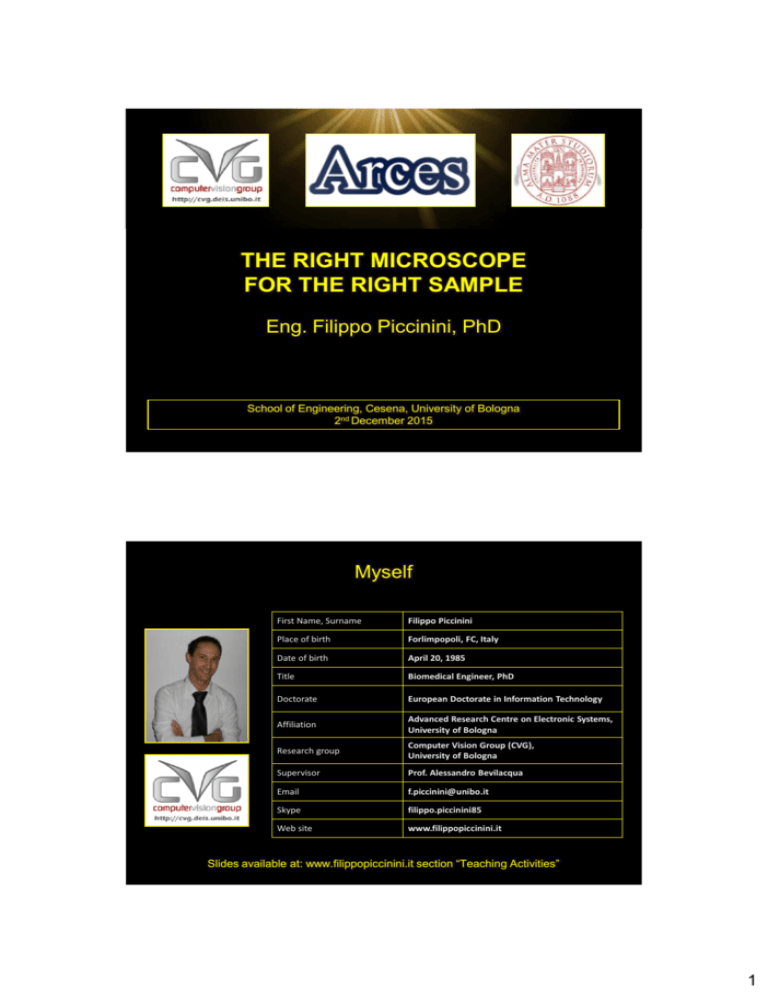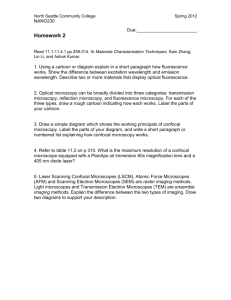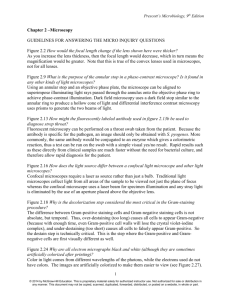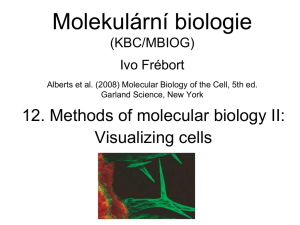Slides PartA - Filippo Piccinini
advertisement

THE RIGHT MICROSCOPE FOR THE RIGHT SAMPLE Eng. Filippo Piccinini, PhD School of Engineering, Cesena, University of Bologna 2nd December 2015 Myself First Name, Surname Filippo Piccinini Place of birth Forlimpopoli, FC, Italy Date of birth April 20, 1985 Title Biomedical Engineer, PhD Doctorate European Doctorate in Information Technology Affiliation Advanced Research Centre on Electronic Systems, University of Bologna Research group Computer Vision Group (CVG), University of Bologna Supervisor Prof. Alessandro Bevilacqua Email f.piccinini@unibo.it Skype filippo.piccinini85 Web site www.filippopiccinini.it Slides available at: www.filippopiccinini.it section “Teaching Activities” 1 ARCES ARCES 2 ARCES Computer Vision Group 3 IMAGE PROCESSING AND ANALYSIS Outdoor imaging Aerospace imaging Biomedical imaging 4 5 COORDINATOR: Dr. Spartaco Santi, Istituto Ortopedico Rizzoli, Bologna COORDINATOR: Dr. Spartaco Santi, Istituto Ortopedico Rizzoli, Bologna Take home message “The right microscope for the right sample” Courtesy of Prof. Ruth Kroschewski The right microscope for the right sample 6 The right microscope for the right sample The right microscope for the right sample 7 The right microscope for the right sample The right microscope for the right sample 8 The right microscope for the right sample The right microscope for the right sample 9 The right microscope for the right sample The right microscope for the right sample 10 Outline Microscopy in general Light microscopes Fluorescence Confocal microscopes Theses and stages Outline Microscopy in general Light microscopes Fluorescence Confocal microscopes Theses and stages 11 Microscopy Courtesy of Prof. Ruth Kroschewski Microscopy Courtesy of Prof. Roger Wepf 12 Microscopy Courtesy of Prof. Roger Wepf Microscopy FEW MATHEMATICS' FORMULAS d 0.6098 v f E h* f Abbe’s law NA d ʎ NA v f E h M = resolution = wavelength = Numerical Aperture = light’s speed = frequency = Energy = Planck constant = magnification Planck’s law 13 Microscopy NUMERICAL APERTURE MICROSCOPYµ TUTORIAL http://www.microscopyu.com/tutorials/java/objectives/nuaperture/index.html M K NA Microscopy THE FUNDAMENTAL COMPONENT Courtesy of Dr. Cristiano Rumio 14 QUESTIONS? WHAT IS THE WAVELENGTH RANGE OF THE VISIBLE REGION? Outline Microscopy in general Light microscopes Fluorescence microscopes Confocal microscopes Theses and stages 15 Light microscopes ITALIANS ALSO IN THE STORY OF MICROSCOPY The first developed microscope was the light (or optical) microscope. An early light microscope was made in 1590 in Netherlands, but the original inventor is not easy to be identified. Giovanni Faber in 1625 coined the name “microscope” for Galileo Galilei's magnification instrumentation. ZEISS AXIOVERT 200 Lab. Cell Culture, IRST Meldola (FC) NIKON ECLIPSE TE 2000-U Cellular and Molecular Eng. Lab., Cesena NIKON ECLIPSE TE 2000-U Lab. Bone Regeneration, IOR Bologna Light microscopes UPRIGHT MICROSCOPE From Optika B-353 Pli User’s Guide 16 Light microscopes From Optika B-353 Pli User’s Guide Light microscopes INVERTED MICROSCOPE OLYMPUS IX71 Lab. Cell Culture, IRST (FC) From Olympus IX71 User’s Guide 17 Light microscopes MICROSCOPES USING REFLECTING LIGHT for surface analysis VEHO 400x COMPACT DIGITAL MICROSCOPE From www.veho-uk.com Take home message For live cell culture analysis INVERTED MICROSCOPE For thin specimen analysis UPRIGHT MICROSCOPE For thick samples analysis MICROSCOPE USING REFLECTING LIGHT 18 Light microscopes ANALYSIS TECHNIQUES: BRIGHTFIELD PHASE-CONTRAST DIFFERENTIAL INTERFERENCE CONTRAST (DIC) Brightfield ADVANTAGES Simplicity of setup with only basic equipment required. LIMITATIONS Very low contrast of most biological samples. The sample often has to be stained before viewing. Mesenchymal stem cell Lung tissue Blood cells 19 Phase-contrast Phase contrast microscopy, first described in 1934 by the Dutch physicist Frits Zernike, is a contrastenhancing optical technique that can be utilized to produce high-contrast images of transparent specimens, such as living cells and thin tissue slices. The phase contrast technique employs an optical mechanism to translate minute variations in phase into corresponding changes in amplitude, which can be visualized as differences in image contrast. http://www.microscopyu.com/tutorials/java/kohler/index.html From www.microscopyu.com Differential Interference Contrast (DIC) DIC microscopy, also known as Nomarski Interference Contrast (NIC), is an optical microscopy illumination technique used to enhance the contrast in unstained, transparent samples. DIC works on the principle of interferometry. The images obtained are similar to those obtained by phase contrast microscopy but without the bright diffraction halo. The DIC images have the appearance of a 3D physical relief corresponding to the variation of optical density of the sample, emphasizing lines and edges though not providing a topographically accurate image. ADVANTAGES Very high contrast of thin samples also not stained. Suitable for live imaging. LIMITATIONS Objectives specific for DIC analysis and not suitable for fluorescence analysis HeLa cells From www.microscopyu.com 20 QUESTIONS? WHAT IS THE BEST MICROSCOPE FOR LIVE CELL CULTURE ANALYSIS? For live cell culture analysis INVERTED MICROSCOPE Outline Microscopy in general Light microscopes Fluorescence Confocal microscopes Theses and stages 21 Fluorescence Fluorescence is the emission of light by a substance that has absorbed light or other electromagnetic radiation of a different wavelength. In most cases, emitted light has a longer wavelength, and therefore lower energy, than the absorbed radiation. From http://en.wikipedia.org Fluorophore A fluorophore (or fluorochrome) is a fluorescent chemical compound that can re-emit light upon light excitation. Courtesy of Dr. Cristiano Rumio 22 Fluorescence Fluorescence 23 Fluorescence Fluorescence 24 Fluorescence QUESTIONS? HOW IS THE ENERGY (HIGHER? LOWER?) OF THE LIGHT EMITTED BY A FLUOROCHROME WITH RESPECT TO ENERGY OF THE EXCITATION LIGHT? d 0.6098 NA v f E h* f 25 QUESTIONS? HOW IS THE ENERGY (HIGHER? LOWER?) OF THE LIGHT EMITTED BY A FLUOROCHROME WITH RESPECT TO ENERGY OF THE EXCITATION LIGHT? d 0.6098 NA v f E h* f Outline Microscopy in general Light microscopes Fluorescence Confocal microscopes Theses and stages 26 Confocal Microscopy THE PRINCIPLE OF CONFOCAL IMAGING WAS PATENTED IN 1957 BY MARVIN MINSKY Characteristics • Fluorescence microscopy • Scanning in x, y and z • Thickness not so critical • Slow for large image area • Pixel by pixel images From www.microscopyu.com Confocal Microscopy www.microscopyu.com/tutorials/java/virtual/confocal/index.html WHAT CAN WE DO? www.microscopyu.com/moviegallery/sweptfield/folu-egfp-eb3-sfc High resolution images Time lapse experiment Z analysis From www.microscopyu.com 27 Confocal Microscopy Bovine pulmonary arthery endothelial cells. Nuclei are stained blue with DAPI, microtubles are marked green by an antibody bound to FITC, actin filaments are labelled red with phalloidin bound to TRITC. Light sheet microscope Zeiss Light Sheet v2.1 28 Light sheet microscope Zeiss Light Sheet v2.1 Light sheet fluorescence microscopy (LSFM) is a fluorescence microscopy technique with good optical sectioning capabilities and high speed. In contrast to epifluorescence microscopy only a thin slice of the sample is illuminated perpendicularly to the direction of observation. For illumination, a laser light-sheet is used. As only the actually observed section is illuminated, this method reduces the photodamage and stress induced on a living sample. Also the good optical sectioning capability reduces the background signal and thus creates images with higher contrast, comparable to confocal microscopy. Because LSFM scans samples by using a plane of light instead of a point (as in confocal microscopy), it can acquire images at speeds 100 to 1000 times faster than those offered by point-scanning methods. LSFM combines good z-sectioning (as confocal) and only illuminates the observed plane. This method is used in cell biology and for microscopy of whole living creatures, such as embryos. Outline Microscopy in general Light microscopes Fluorescence Confocal microscopes Theses and stages 29 Computer Vision Group To: ARCES, Bologna Theses and stages in: Image correction techniques: vignetting, depth-of-focus, mosaicing. Analysis of images acquired by flying drones Cellular and Molecular Engineering Laboratory To: School of Engineering, Cesena Theses and stages in: Bacterial segmentation and tracking Fluorescent signal normalization for analysis of synthetic biology circuits 30 Radiobiology Laboratory To: IRCCS-IRST, Meldola (FC) Theses and stages in: Multicellular cancer aggregates analysis Radiotherapy and chemotherapy protocol analysis for lung cancer Bone Regeneration Laboratory To: Istituto Ortopedico Rizzoli, Bologna Theses and stages in: Mesenchymal Stem Cell characterization and differentiation Regeneration Medicine for bone cancer 31 Light Microscopy and Screening Centre To: Swiss Federal Institute of Technology (ETH), Zurich, Switzerland Theses and stages in: Cellular screening analysis Microscopic imagery tracking, detection, segmentation Synthetic and Systems Biology Unit To: Biological Research Centre, Szeged, Hungary Theses and stages in: Microscopic image segmentation and tracking Machine learning methods 32 THANK YOU! Filippo Piccinini f.piccinini@unibo.it 33








